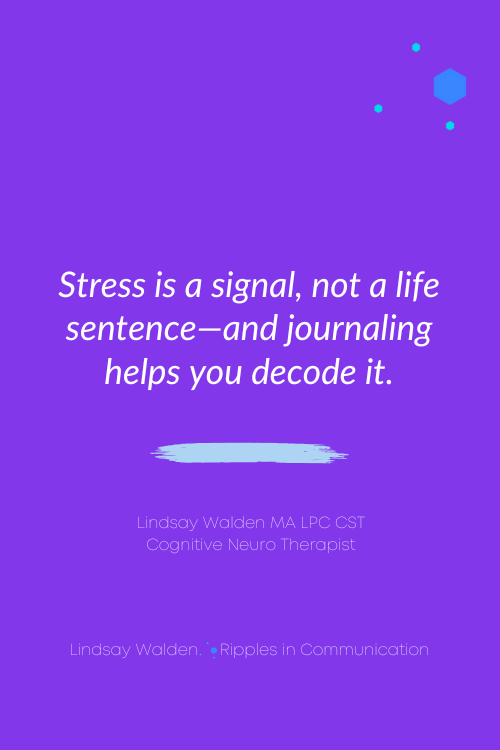Can’t Turn Your Brain Off? Here’s How to Calm the Chaos
Have you ever had one of those days where your mind just won't shut off?
You're trying to focus, rest, or even just enjoy a quiet moment—but your thoughts keep racing:
“I have too much to do.”
“What if something goes wrong?”
“I feel behind and don’t know how to fix it.”
“I’m so tired—but I can’t stop thinking.”
When stress builds, it’s not just in your head—it’s in your body. Your nervous system goes into overdrive, your thoughts loop in circles, your muscles stay tight, and your energy drains. You might feel exhausted but wired, desperate for relief, and unsure how to actually get it.
Here’s what’s really happening: When your brain perceives a threat—real or imagined—it activates the fight-or-flight response, flooding your system with cortisol and keeping you in a heightened state of alertness. This is helpful if you’re running from danger. But if the threat is a growing to-do list or a thought spiral about what might go wrong, it just leaves you feeling stuck, anxious, and overwhelmed.
The good news? There’s a way to break this cycle. And it doesn’t require a two-hour meditation or a weeklong vacation.
It starts with something simple: writing things down.
Have you grabbed your FREE CNT Toolkit Sampler yet?
Have you grabbed your FREE CNT Toolkit Sampler yet? It’s packed with science-backed tools designed to help you regulate emotions, manage stress, and develop deep self-awareness. If you’ve ever felt overwhelmed by your reactions or stuck in negative thought patterns, this toolkit will give you the proven strategies I use with clients to help them strengthen emotional neutrality, rewire unhelpful responses, and build lasting resilience. Inside, you’ll find practical exercises and guided reflections to help you navigate challenges with clarity and confidence. Enter your email below, and I’ll send it straight to your inbox!
Why Writing Calms an Overactive Mind
You’ve probably heard that journaling helps with stress, but what you may not know is why it works.
From a neuroscience perspective, journaling actually shifts your brain out of a reactive state and into a calm, regulated one. Here's how:
It activates the prefrontal cortex, the part of your brain responsible for rational thinking and problem-solving. This pulls you out of emotional reactivity and back into grounded, logical processing.
It reduces amygdala activity, which is your brain’s fear and threat detector. When this calms down, so does your nervous system.
It gives your body permission to stop producing stress hormones—because your mind no longer thinks it’s under attack.
In short: journaling works like a mental detox. It helps your brain offload anxious, repetitive thoughts so they don’t have to keep spinning in your head all day.
Three Therapist-Approved Journaling Techniques for Stress Relief
If your mind is racing and your body is tense, these are three simple, science-backed writing methods that can bring immediate relief.
1. The Write-and-Release Method
This technique is perfect for moments when you feel overwhelmed and need a fast emotional reset.
Set a timer for five minutes. Write down everything that’s swirling in your mind—fears, frustrations, to-do list items, worst-case scenarios. Don’t worry about punctuation or structure. This isn’t for anyone else to read. It’s for you to release.
When your timer ends, close your journal. If it feels helpful, you can tear out the page and throw it away.
Here’s why it works: Your brain treats writing like an offloading system. Once a thought is on paper, your brain no longer feels the need to keep obsessing over it. This process tells your mind, “You can let go now.”
2. The Anxiety Reframe Exercise
This technique is best when you’re stuck in worst-case-scenario thinking.
Start by writing down the one thought or situation that’s creating the most anxiety. Then, underneath it, answer the following:
What’s the absolute worst-case scenario?
What’s the most realistic outcome?
What’s one thing I can control right now?
For example:
Stress trigger: “What if I mess up my big presentation?”
Worst-case scenario: “I freeze, forget everything, and people judge me.”
Most realistic scenario: “I’ll be nervous, but I’ll get through it just fine.”
One thing I can control: “I can practice my key points tonight.”
This technique rewires your brain to separate fear-based thinking from reality-based problem-solving. The more you practice this, the easier it becomes to catch anxious thoughts before they spiral.
3. The 5-4-3-2-1 Grounding Method
If your stress feels more physical—like a racing heart, tight chest, or buzzing restlessness—this grounding method helps bring you back to the present.
In your journal, write down:
Five things you can see
Four things you can touch
Three things you can hear
Two things you can smell
One thing you can taste
This sensory exercise gently pulls your attention away from racing thoughts and anchors you in your body and environment. When your nervous system can sense safety in the present moment, it starts to relax—and so do you.
Try This Right Now: The 3-Minute Stress Release Challenge
If you're feeling overwhelmed as you read this, try this quick reset:
Set a timer for three minutes.
Write down everything that’s bothering you—no filter, no structure.
When the timer goes off, close your journal and take a deep breath.
It doesn’t take long to shift your state—just intention and space to do it.
Why the Anytime Journal Works (Especially on Overwhelming Days)
Unlike traditional planners or notebooks, the Anytime Journal was designed to meet you where you are—especially when you’re in stress mode.
It gives you structure when your brain feels chaotic. It offers prompts that calm, ground, and redirect your thinking. And most importantly, it helps you move from anxious thoughts to aligned action.
This isn’t about suppressing emotions or pushing through. It’s about processing what’s happening so it no longer owns your day.
Final Thoughts: Stress Is a Signal, Not a Life Sentence
Most of us were taught to either ignore stress or push through it. But neither of those approaches address what’s happening inside your brain and body.
Stress is your mind’s way of saying, “Something needs attention.”
When you slow down and give it space—through writing, reflection, and gentle inquiry—you tell your nervous system, “It’s okay. I’ve got this.” And from there, clarity, calm, and energy start to return.
So next time your brain won’t stop spinning, don’t wait until you hit a breaking point. Give yourself just five minutes to pause, write, and release.
Your future self—calmer, clearer, and more in control—will thank you for it.
→ Want tools to journal your way out of stress? Check out the Anytime Journal in the CNT Toolkit Shop.







